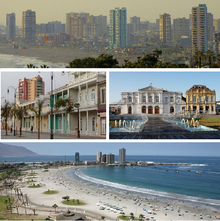The Tarapacá Region (Spanish: Región de Tarapacá, pronounced [taɾapaˈka]) is one of Chile's 16 first-order administrative divisions. It comprises two provinces, Iquique and Tamarugal. It borders the Chilean Arica y Parinacota Region to the north, Bolivia's Oruro Department and Potosí Department on the east, Chile's Antofagasta Region to the south and the Pacific Ocean to the west. The port city of Iquique is the region's capital.
Tarapacá Region
Región de Tarapacá | |
|---|---|
 Cerros Pintados geoglyphs, Pampa del Tamarugal National Reserve | |
 Map of Tarapacá Region | |
| Coordinates: 20°17′S 69°20′W / 20.283°S 69.333°W | |
| Country | |
| Capital | Iquique |
| Provinces | Iquique, Tamarugal |
| Government | |
| • Intendant | Miguel Quezada Torres (UDI) |
| Area | |
• Total | 41,799.5 km2 (16,138.9 sq mi) |
| • Rank | 6 |
| Lowest elevation | 0 m (0 ft) |
| Population (2017 census)[1] | |
• Total | 324,930 |
| • Rank | 12 |
| • Density | 7.8/km2 (20/sq mi) |
| GDP (PPP) | |
| • Total | $9.076 billion (2014) |
| • Per capita | $27,604 (2014) |
| ISO 3166 code | CL-TA |
| HDI (2019) | 0.882 [3] very high |
| Website | Official website (in Spanish) |



Much of the region was once the Tarapacá Province of Peru, which was annexed by Chile under the 1883 Treaty of Ancón at the close of the War of the Pacific. The region was important economically as a site of intense saltpeter mining, before synthetic nitrate manufacturing became possible. A number of abandoned mining towns can still be found in the region.
The present day Tarapacá Region was created in 2007 by subdividing the former Tarapacá Region under Law No. 20,175, which was signed by President Michelle Bachelet in Arica.[4]
Administration
editThe government of the region resides in the intendant, who is assigned by the president. Each of the region's two provinces are further subdivided into communes.
| Province | Capital | Commune | Other towns |
|---|---|---|---|
| Iquique | Iquique | Iquique | |
| Alto Hospicio | |||
| Tamarugal | Pozo Almonte | ||
| Huara | Pisagua | ||
| Camiña | |||
| Colchane | |||
| Pica | |||
| Pozo Almonte | Mamiña |
Climate
editA desert climate dominates the region. Near the coast, cloudiness can limit the temperature swing throughout the day, but in other drier areas, temperatures can vary greatly as is typical in deserts. A marginal desert region can be found over 3,000 m (9,843 ft) above sea level, which sees milder temperatures and summer rains.[4]
Rivers
edit- Isluga River
- Cariquima
- Concosa (Altiplano)
Economic activities
edit- Fishing
- Tourism
- Mining
See also
editReferences
edit- ^ a b "Tarapacá Region". Government of Chile Foreign Investment Committee. Retrieved 13 March 2010.[permanent dead link]
- ^ Regions and Cities > Regional Statistics > Regional Economy > Regional GDP per Capita, OECD.Stats.
- ^ "Sub-national HDI - Area Database - Global Data Lab". hdi.globaldatalab.org. Retrieved 26 October 2021.
- ^ a b "Arica-Parinacota Region". 9 March 2010. Retrieved 9 March 2010.[permanent dead link]
External links
edit- Gobierno Regional de Tarapacá Official website (in Spanish)
- Visita Tarapacá Web platform with useful information about the Tarapacá region (in Spanish and English)

